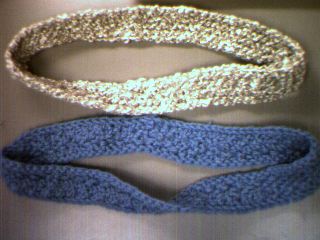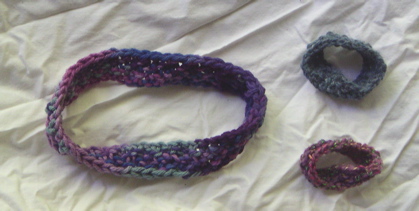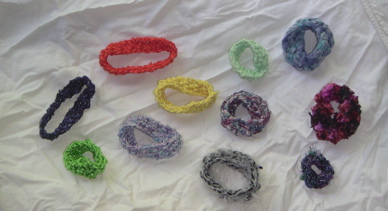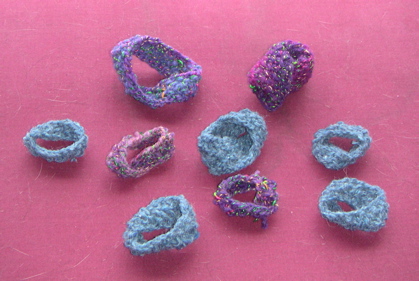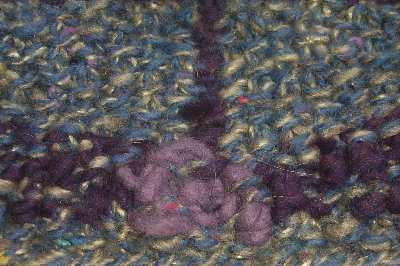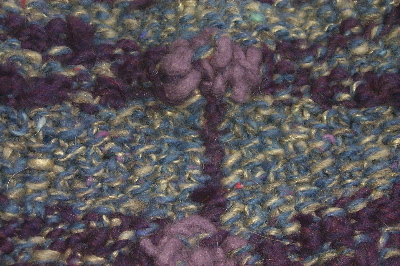How to Knit a Möbius Band (or Möbius
Strip) with an intrinsic twist
(For any mathematicians reading this, note that the first two methods are
basically forming an S1 and forming the strip by adding a layer to
the bottom, then top, then bottom, etc. Also, while such Möbius bands are
essentially seamless, they still contain glide-reflection with glide one-half
stitch. This is induced by knitting into the loops between the stitches, which
is necessary in order to form the intrinsic twist.)
Method 1: Knit from the inside out, using scrap yarn.
You'll need two different colors of yarn, one for the Möbius band itself and
a scrap yarn for casting on. I find plain cotton yarn the easiest to work with
in all cases, but especially for the scrap. You'll also need a sufficiently
flexible circular needle. I think I usually use a size 7 or 8 in 24" length for
this, but other sizes should work as well.
Cast on 90 stitches in your scrap yarn. Because you'll be removing the scrap
yarn later, use a cast on method that easily pulls out. (My favorite is
basically a crochet chain cast on; thanks to Cindy Kraus for explaining it to
me. I create a slipknot loop and, using my fingers, pull another loop through
it to start. Then I wrap the free end of the yarn over the needle, and (again
using my fingers) pull a loop through the previous loop. Then I repeat. If that
made no sense, try this
description instead.) In case you're wondering why the scrap yarn is
necessary at all, it's to avoid any appearance of a seam in the finished
product.
This means that your Möbius band will have a central circle of 90 stitches
in circumference. If you're making a wearable Möbius band rather than just a
mathematical manipulative, you will of course want to adjust this number for
gauge and fit.
Onto the cast-on row, knit one row loosely, using the
yarn-for-the-Möbius-band-itself. Leave a bit of a tail when you begin so that
you have some to knit in when you're done. (No knots allowed!) Note: you may
want to purl one row instead. I think that whether you should purl or knit
depends on the handedness of your cast-on row and the handedness of your
knitting; the point is that some ways of knitting will ensnare the scrap yarn
so it won't pull out easily, so be aware of the issue.
Now, if you were doing ordinary circular knitting, you'd continue by
stretching the other end of your row to the other tip of the needle, and
knitting onto that. However, you're going to introduce the intrinsic twist by
instead knitting into the loops between the stitches of the row you just knit.
In order to do this, don't stretch the other end of the row.
Leave it where it is, and bring the tip of the needle to it. Then rotate
the-other-end-of-the-row a bit so that you can access the loops between your
stitches. Because these loops are not at the tip of a needle, you cannot do the
ordinary (insert needle into loop)-(wrap yarn 'round needle)-(pull new loop
through old)-(slide old loop off needle). Instead, you'll just do the first
three of these operations, leaving your old loops still on the skinny part of
the circlar needle... but instead of just knitting or just purling, you must
*k1p1*. This has the effect of casting on an additional 89 stitches so that
each 'row' has 179 stitches. (Note that if you cast on n stitches
originally, knitting into the loops between will add n-1 stitches,
giving an odd number of stitches total. This ensures that your *k1p1* will
become seed stitch rather than ribbing, and that your seam will be invisible.)
Bizarre though this may seem, it's consistent with the fact that a Möbius Band
has only one edge, so it will appear that you'll be knitting twice 'round the
strip to traverse the edge once. Also, this will probably hurt your fingers or
at least be rather uncomfortable, so don't be shocked when that happens.
When you've finished knitting into the loops-between-the-stitches, your
needle will be loop-de-looped. Now you can just do *k1p1* forever, or rather,
until you feel like you're done. For a cute li'l strip, five 'rows' should be
fine. For a scarf, you'll want more like twenty.
When you're done, just cast off as usual. There are three tasks that remain:
knit in the end of the yarn, get rid of the scrap yarn, and knit in the
beginning of the yarn. When knitting in the beginning of the yarn, look
carefully at your stitches so that you don't create a hole or piece of seam.
This is a modified/expanded version of Maria Iano-Fletcher's translation of
Miles Reid's pattern.
Method 2: Knit from the inside out, no scrap yarn
needed.
Once you're used to it, this is the fastest method. However, the yarn
forming the central circle doesn't look quite as spiffy as when scrap yarn is
used, because this method induces a little bit of additional torque on the
yarn. (At least, it does when I do it. This could be a peculiarity of my
less-than-orthodox left-handed knitting style.) Also, lots of people seem to
have trouble figuring out how to do this, so be forewarned that it does require
some thinking.
You'll need some yarn and a circular needle that can coil twice 'round a
circle (the way they're conventionally used requires that they coil only once
'round a circle). Make a slip knot and slip it over one point of your needle.
Grab the point in your right hand and hold the knot so it doesn't slide away.
Bend the needle so that the other point is (a) pointing to the left (b) in
front of the point with the slipknot (c) in front of the yarn. Now, using the
cable instead of a piece of scrap yarn, do stranded cast-on. (Online
instructions can be found on YouTube by Cat
Bordhi---note that to be mathematically correct, you'll need to omit her
last yo in order to have an odd number of stitches---or on Eunny
Jang's blog. Printed instructions for stranded cast-on can be found in June
Hemmons Hiatt's The Principles of Knitting, p. 138 of the first edition; in Mary
Thomas's Knitting Book, p. 66, it's called invisible cast-on.) The number
of stitches you cast on will be the number in the central circle of the Möbius
band, which is roughly half the number of stitches on the boundary of the
Möbius band. Pull the yarn to the front, so that it's coming toward you from
behind the cable (not the point of the needle). This will ensure that you end
up with an odd number of stitches, which is necessary for the whole seed stitch
thing to work out correctly.
What you do next depends on your handedness. If you're left-handed, like me,
you'll turn the whole business around and knit into the slip knot. If you're
right-handed, you'll purl into the slip knot. After that, continue in seed
stitch (*k1p1*), always knitting/purling by slipping the needle into the side
of the stitch closest to you. I know, that sounds silly to say---that's how we
always knit/purl---but you might feel like you're putting the needle in from a
funny direction or in a funny piece of the stitch. And you might actually be.
Just alter your usual stitch in whatever way you have to, so that none of your
stitches twist. (If that confuses you, I recommend reading The Principles
of Knitting, pages 23-24 and 32-34 of the first edition, or Anna Zilboorg's Knitting for
Anarchists, pages 14-22.)
Then keep going until you've reached the desired width. Bind off in pattern
and weave in the end. Now go back, untie the slip knot (which may take some
doing) and weave in that end in pattern as well, being careful not to leave a
hole. If you don't remove the slip knot, it will be very easy to see where you
started.
Method 3: Knit from the outside in
Catherine Kehr sent me this method. I find it more difficult to do because
(a) the contortions required just before the final graft are not easy and (b)
trying to decide exactly which stitches should match up for the graft is hard,
and an error will create a hole. In other words, I have to think too much using
Catherine's method *grin*. The text below is mostly Catherine's, but slightly
edited by me.
First, make a Möbius strip out of paper. If you're ambitious, color the edge
so you can keep track of it later. Slice it in half down the midline. You will
see that you now have one big ring with two full 360-degree twists in it instead of
one small ring with a 180-degree twist. It's now 720 degrees because you took two 180s (the two
halves of the Möbius strip) and pulled them into a ring by adding another full
twist (this isn't the most scientific explanation, but it's essentially
correct). Now try to put the Möbius strip back together, because you'll need to
do this operation on your knitting.
Using yarn this time, and a circular needle, cast on 500 sts (or whatever
twice your preferred finished length would be). Add two full twists and then
join the knitting into a (twisted) circle. Knit to half your preferred width.
Now twist it into the form of a Möbius strip and graft.
Catherine says: "For those of you who think this might be 'cheating' -- this
technique is as legitimate a one-edged construction as inside-out (but with
less harangue and more invisibility). Grafting the midline is no different than
the grafting technique used when knitting inside out (aka invisble or
provisional cast-on)."
There were, and may someday again be, some more-detailed instructions (including photos) for this
construction method at the girl from
auntie, but note that the sample has a seam so as to illustrate where to
graft, and isn't made from a symmetric stitch.
